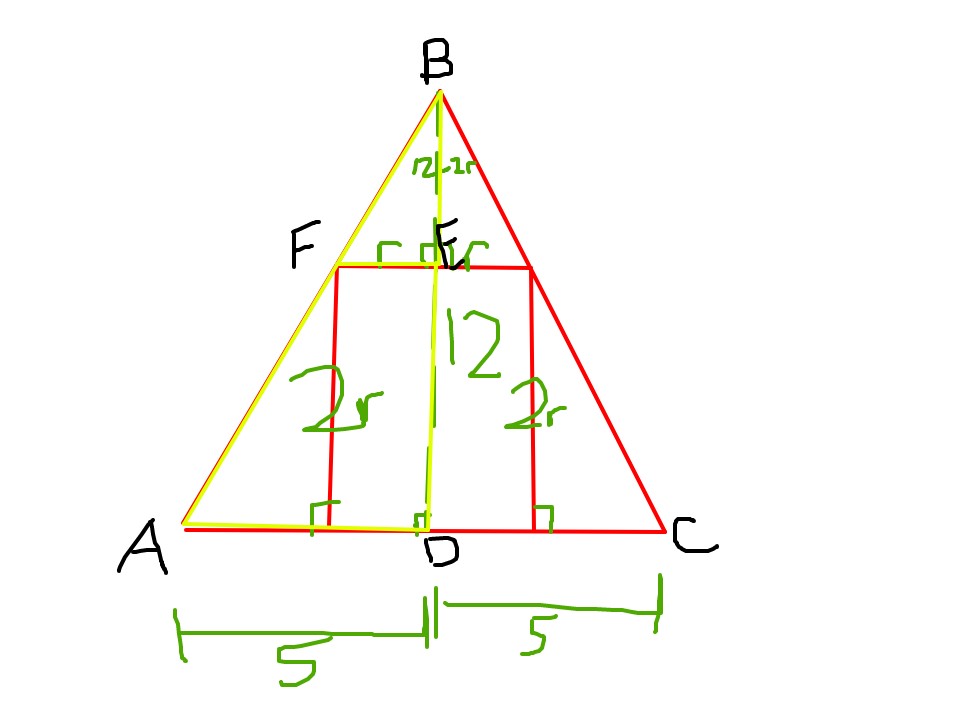Difference between revisions of "2001 AMC 10 Problems/Problem 21"
| Line 5: | Line 5: | ||
<math> \textbf{(A)}\ \frac{8}3\qquad\textbf{(B)}\ \frac{30}{11}\qquad\textbf{(C)}\ 3\qquad\textbf{(D)}\ \frac{25}{8}\qquad\textbf{(E)}\ \frac{7}{2} </math> | <math> \textbf{(A)}\ \frac{8}3\qquad\textbf{(B)}\ \frac{30}{11}\qquad\textbf{(C)}\ 3\qquad\textbf{(D)}\ \frac{25}{8}\qquad\textbf{(E)}\ \frac{7}{2} </math> | ||
| − | ==Solution== | + | ==Solution 1== |
<asy> | <asy> | ||
| Line 35: | Line 35: | ||
Let the diameter of the cylinder be <math> 2r </math>. Examining the cross section of the cone and cylinder, we find two similar triangles. Hence, <math> \frac{12-2r}{12}=\frac{2r}{10} </math> which we solve to find <math> r=\frac{30}{11} </math>. Our answer is <math> \boxed{\textbf{(B)}\ \frac{30}{11}} </math>. | Let the diameter of the cylinder be <math> 2r </math>. Examining the cross section of the cone and cylinder, we find two similar triangles. Hence, <math> \frac{12-2r}{12}=\frac{2r}{10} </math> which we solve to find <math> r=\frac{30}{11} </math>. Our answer is <math> \boxed{\textbf{(B)}\ \frac{30}{11}} </math>. | ||
| + | |||
| + | ==Solution 2== | ||
| + | |||
| + | <math>\text{We can begin by drawing a diagram with the given information}</math>: | ||
| + | |||
| + | [[File:2001amc10solution.jpg]] | ||
| + | |||
| + | We are asked to find the radius of the cylinder, or <math>r</math> so we can look for similarity. We know that <math>\angle BEF = \angle BDA</math> and <math>\angle FBE = \angle ABD</math>, thus we have similarity between <math>\triangle BFE</math> and <math>\triangle BAD</math> by <math>AA</math> similarity. | ||
| + | |||
| + | Therefore, we can create an equation to find the length of the desired side. We know that: | ||
| + | |||
| + | <math>\frac{BE}{BD}=\frac{FE}{AD}.</math> | ||
| + | |||
| + | Plugging in yields: | ||
| + | |||
| + | <math>\frac{12-2r}{12}=\frac{r}{5}.</math> | ||
| + | |||
| + | Cross multiplying and simplifying gives: | ||
| + | |||
| + | <math>5(12-2r)=12r</math> | ||
| + | |||
| + | <math>\Downarrow</math> | ||
| + | |||
| + | <math> r=\frac{30}{11}.</math> | ||
| + | |||
| + | <math>Since the problem asks us to find the radius of the cylinder, we are done and the radius of the cylinder is</math> <math>\boxed{\textbf{(B)}\ \frac{30}{11}}</math>. | ||
| + | |||
| + | ~etvat | ||
==See Also== | ==See Also== | ||
Revision as of 16:07, 15 February 2021
Contents
[hide]Problem
A right circular cylinder with its diameter equal to its height is inscribed in a right circular cone. The cone has diameter ![]() and altitude
and altitude ![]() , and the axes of the cylinder and cone coincide. Find the radius of the cylinder.
, and the axes of the cylinder and cone coincide. Find the radius of the cylinder.
![]()
Solution 1
![[asy] draw((5,0)--(-5,0)--(0,12)--cycle); unitsize(.75cm); draw((-30/11,0)--(-30/11,60/11)); draw((-30/11,60/11)--(30/11,60/11)); draw((30/11,60/11)--(30/11,0)); draw((0,0)--(0,12)); label("$2r$",(0,30/11),E); label("$12-2r$",(0,80/11),E); label("$2r$",(0,60/11),S); label("$10$",(0,0),S); label("$A$",(0,12),N); label("$B$",(-5,0),SW); label("$C$",(5,0),SE); label("$D$",(-30/11,60/11),W); label("$E$",(30/11,60/11),E); [/asy]](http://latex.artofproblemsolving.com/8/a/4/8a48ba1b569474a4227381a6d073567c8d68ddf3.png)
Let the diameter of the cylinder be ![]() . Examining the cross section of the cone and cylinder, we find two similar triangles. Hence,
. Examining the cross section of the cone and cylinder, we find two similar triangles. Hence, ![]() which we solve to find
which we solve to find ![]() . Our answer is
. Our answer is ![]() .
.
Solution 2
![]() :
:
We are asked to find the radius of the cylinder, or ![]() so we can look for similarity. We know that
so we can look for similarity. We know that ![]() and
and ![]() , thus we have similarity between
, thus we have similarity between ![]() and
and ![]() by
by ![]() similarity.
similarity.
Therefore, we can create an equation to find the length of the desired side. We know that:
![]()
Plugging in yields:
![]()
Cross multiplying and simplifying gives:
![]()
![]()
![]()
![]()
![]() .
.
~etvat
See Also
| 2001 AMC 10 (Problems • Answer Key • Resources) | ||
| Preceded by Problem 20 |
Followed by Problem 22 | |
| 1 • 2 • 3 • 4 • 5 • 6 • 7 • 8 • 9 • 10 • 11 • 12 • 13 • 14 • 15 • 16 • 17 • 18 • 19 • 20 • 21 • 22 • 23 • 24 • 25 | ||
| All AMC 10 Problems and Solutions | ||
The problems on this page are copyrighted by the Mathematical Association of America's American Mathematics Competitions. ![]()










